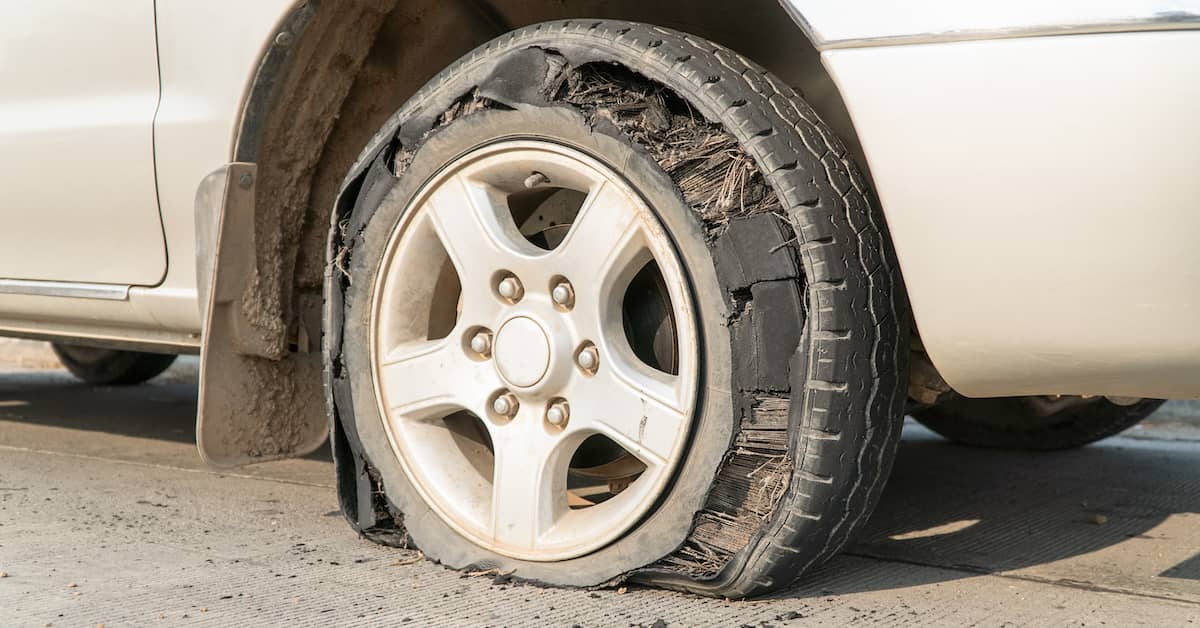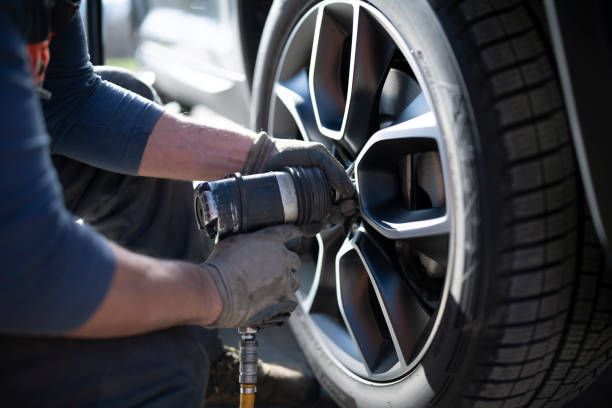Tire blowouts occur due to under-inflation, overloading, or hitting road hazards. Worn-out tires also increase the risk.
Tire blowouts can be dangerous and cause accidents. Proper tire maintenance is crucial to prevent these incidents. Regularly check tire pressure and ensure they are not over or under-inflated. Avoid overloading your vehicle beyond its capacity. Inspect your tires for wear and tear, and replace them when needed.
Be cautious on the road to avoid sharp objects and potholes. Knowing the common causes and taking preventive measures can help maintain tire integrity. This ensures safer driving experiences and reduces the likelihood of blowouts. Stay informed and proactive about tire care for optimal safety.
Common Causes
Tire blowouts can be sudden and dangerous. Understanding the common causes can help prevent them. This section delves into the reasons tires fail.
Underinflation
Underinflation is a leading cause of tire blowouts. Tires need the right amount of air pressure. Low air pressure makes tires bend and flex too much. This generates heat, causing the tire to weaken. Over time, the tire can no longer hold together and bursts.
Regularly checking tire pressure is essential. Use a reliable gauge to ensure tires are properly inflated. Refer to the vehicle’s manual for the correct pressure levels. Keeping tires at the recommended pressure can save lives.
Overloading
Overloading a vehicle also contributes to tire blowouts. Every vehicle has a maximum weight limit. Exceeding this limit puts extra stress on tires. This can cause them to fail.
Before loading your vehicle, check the weight capacity. This information is usually found in the owner’s manual or on a sticker inside the door frame. Distribute the weight evenly and avoid exceeding the limit. Proper loading helps maintain tire integrity.
| Common Cause | Description |
|---|---|
| Underinflation | Tires bend and flex too much, generating heat. |
| Overloading | Excess weight puts stress on tires, causing failure. |
Ensuring your vehicle’s tires are properly maintained can prevent blowouts. Regular checks and mindful loading are key steps.

Road Hazards
Tire blowouts can be dangerous. They are often caused by road hazards. These hazards are everywhere. They damage tires and cause blowouts.
Potholes
Potholes are common on many roads. They form from wear and tear. Hitting a pothole at high speed can damage tires. This damage can lead to a blowout.
Potholes can be hard to see. They are often filled with water. Drivers should be cautious. Avoid potholes if possible. Slow down when driving over them.
Debris
Debris on the road is another hazard. This includes things like nails, glass, and sharp objects. Driving over debris can puncture tires. This can cause a sudden blowout.
Road debris can be anywhere. It may come from accidents or fallen cargo. Always keep an eye on the road. Avoid driving over debris whenever you can.
| Type of Debris | Potential Damage |
|---|---|
| Nails | Punctures tire, slow air leak |
| Glass | Punctures tire, immediate blowout |
| Metal shards | Cuts tire, severe damage |
Stay safe on the road. Be aware of your surroundings. Your tires will thank you!
Weather Conditions
Tire blowouts are often caused by various weather conditions. Extreme temperatures can impact tire performance and safety. Let’s explore how different weather conditions affect tires.
Extreme Heat
Extreme heat can cause tires to overheat. Overheated tires may lead to blowouts.
- High temperatures increase tire pressure.
- Over-inflated tires are more prone to damage.
- Heat can weaken tire materials.
| Heat Effect | Result |
|---|---|
| Increased pressure | Higher blowout risk |
| Material weakening | Tire failure |
Cold Temperatures
Cold temperatures also affect tire safety. Cold weather can lead to under-inflation.
- Low temperatures reduce tire pressure.
- Under-inflated tires wear out faster.
- Cold can make tires brittle.
| Cold Effect | Result |
|---|---|
| Reduced pressure | Faster wear |
| Brittle tires | Higher blowout risk |
Tire Maintenance
Proper tire maintenance is crucial for safe driving. It helps prevent tire blowouts. Regular checks and maintenance can save lives and money. Below are key aspects of tire maintenance to focus on.
Tread Wear
Tread wear affects tire performance. Worn-out treads increase the risk of blowouts. Check tire treads regularly. Use a tread depth gauge to measure them. Tires should be replaced when tread depth is too low.
| Tread Depth | Condition |
|---|---|
| Above 4/32 inch | Safe |
| 2/32 to 4/32 inch | Monitor |
| Below 2/32 inch | Replace |
Regular Inspections
Conduct regular inspections to spot potential issues. Inspect tires for cuts, punctures, and bulges. Look for signs of uneven wear. Uneven wear might indicate alignment issues.
- Check tire pressure monthly.
- Rotate tires every 5,000 to 7,000 miles.
- Balance tires to avoid uneven wear.
Manufacturing Defects
Tire blowouts can be a terrifying experience. One often overlooked cause is manufacturing defects. These defects can compromise the tire’s integrity, leading to sudden failures.
Material Flaws
Material flaws occur when tires are made with substandard materials. Tires consist of various layers, including rubber, fabric, and steel. If any material is weak, the tire becomes prone to blowouts.
For example, a tire may have weak rubber due to poor quality control. Weak rubber can tear easily under pressure. Similarly, steel belts may not be strong enough to hold the tire together. These flaws can cause the tire to rupture unexpectedly.
Common material flaws include:
- Poor quality rubber
- Weak steel belts
- Inferior fabric layers
Design Issues
Design issues can also lead to tire blowouts. A tire with a flawed design may not handle stress well. This can result in dangerous situations.
For instance, a tire with an improper tread pattern can wear out unevenly. Uneven wear can weaken certain areas, making them susceptible to blowouts. Additionally, inadequate sidewall strength can cause the tire to fail under heavy loads.
Common design issues include:
- Improper tread pattern
- Weak sidewalls
- Poor internal structure
Manufacturing defects, whether due to material flaws or design issues, can significantly increase the risk of tire blowouts. Always ensure your tires come from reputable manufacturers to avoid these problems.

Driving Habits
Understanding what causes tire blowouts is crucial for safe driving. One major factor is driving habits. Your driving habits can significantly affect your tire’s lifespan and safety.
Speeding
Speeding is a common cause of tire blowouts. Tires have a speed rating. Exceeding this rating weakens the tire structure. High speeds generate more heat. This causes tires to expand and may lead to a blowout.
- Always adhere to speed limits.
- Check your tire’s speed rating.
- Drive at safe speeds, especially on hot days.
Sudden Stops
Sudden stops can also lead to tire blowouts. Abrupt braking causes intense friction. This friction heats up the tire. Rapid temperature changes weaken the tire, making it prone to blowouts.
- Maintain a safe distance from other vehicles.
- Brake smoothly to avoid sudden stops.
- Regularly check tire pressure to ensure safety.
| Driving Habit | Impact on Tires |
|---|---|
| Speeding | Weakens tire structure |
| Sudden Stops | Causes intense friction |
Adopting better driving habits can help prevent tire blowouts. Stay safe by driving responsibly.
Preventive Measures
Preventing tire blowouts is essential for safe driving. Simple steps can help avoid these dangerous events. Understanding and practicing preventive measures ensures longer tire life and safer journeys.
Proper Inflation
Maintaining proper tire inflation is crucial. Over-inflated or under-inflated tires can cause blowouts. Always check tire pressure with a gauge. Refer to your vehicle’s manual for the correct pressure.
Here are some quick tips:
- Check tire pressure monthly.
- Check pressure before long trips.
- Check pressure when tires are cold.
Weight Limits
Respecting weight limits is vital. Overloading your vehicle stresses the tires. Always know your vehicle’s load capacity.
Consider these guidelines:
- Refer to the owner’s manual for load limits.
- Distribute weight evenly across the vehicle.
- Avoid carrying unnecessary heavy items.
| Weight Limit | Impact on Tires |
|---|---|
| Within Limit | Safe and stable |
| Over Limit | High blowout risk |

Emergency Response
Experiencing a tire blowout can be terrifying. Knowing how to respond is crucial for safety. Quick, calm actions can prevent accidents and injuries.
Handling Blowouts
First, stay calm. Panic can lead to dangerous mistakes. Keep your hands on the steering wheel. Do not slam the brakes. Instead, press the accelerator slightly. This will help maintain control.
Let the car slow down gradually. Steer the car straight. When the speed is under control, move to the side of the road. Make sure to use your turn signals.
Once you stop, turn on your hazard lights. This alerts other drivers. Be cautious when exiting the vehicle. Always check for traffic.
Safety Protocols
Safety should be your top priority. Follow these protocols to stay safe:
- Always carry a spare tire.
- Keep a tire jack and lug wrench in your vehicle.
- Check tire pressure regularly.
- Inspect tires for wear and tear.
- Replace old or damaged tires.
In case of a blowout, use the spare tire. If you lack a spare, call for roadside assistance. Never attempt tire changes on busy highways.
| Action | Priority |
|---|---|
| Stay calm | High |
| Control steering | High |
| Turn on hazard lights | Medium |
| Move to safety | High |
| Call for help | Medium |
Following these steps can keep you safe during a tire blowout. Always be prepared and stay alert.
Frequently Asked Questions
What Is The Most Common Cause Of Tire Blowouts?
The most common cause of tire blowouts is underinflated tires. Underinflation causes excessive flexing and overheating, leading to blowouts.
Why Do I Keep Getting Tire Blowouts?
Tire blowouts often happen due to underinflation, overloading, or hitting potholes. Regularly check tire pressure and avoid overloading. Ensure your tires are in good condition and properly inflated.
How Do You Prevent A Tire Blowout?
Regularly check tire pressure, avoid overloading, inspect for damage, rotate tires, and drive carefully to prevent blowouts.
What To Do If Your Tire Blows Out While Driving?
Stay calm. Grip the steering wheel firmly. Gradually ease off the accelerator. Do not brake suddenly. Safely steer to the shoulder.
Conclusion
Regular tire maintenance is crucial to prevent blowouts. Check tire pressure and tread regularly. Avoid overloading your vehicle. Stay vigilant for road hazards. Following these steps can ensure safer driving and prolong tire life. Always prioritize safety and keep your tires in optimal condition.
Safe travels!





















